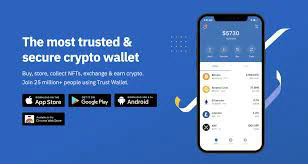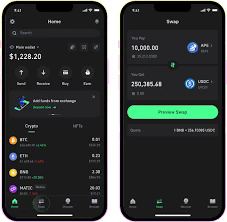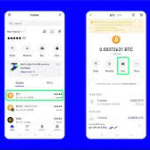# Can My Trust Wallet Be Hacked? An In-Depth Analysis
## Introduction to Trust Wallet
Trust Wallet is a decentralized mobile cryptocurrency wallet owned by Binance, designed to store, manage, and trade a variety of cryptocurrencies and digital assets securely. Launched in 2017, the wallet has rapidly gained popularity due to its user-friendly interface, support for various cryptocurrencies including Ethereum and ERC20 tokens, and integrated decentralized exchange (DEX) features.
In an era where digital assets are becoming ubiquitous, the security of these wallets is paramount. Users often wonder, “Can my Trust Wallet be hacked?” This article seeks to explore the potential risks associated with Trust Wallet, the underlying technology, and the necessary precautions users should take to protect their assets.
## Understanding the Architecture of Trust Wallet
To understand the security of Trust Wallet, we must delve into its architecture. Trust Wallet is a non-custodial wallet, meaning that users have full control over their private keys. Private keys are crucial, as they grant access to the blockchain and the assets held within it. Trust Wallet employs a hierarchical deterministic (HD) wallet structure, which generates a new address for each transaction, ensuring increased privacy and security.
### Private Keys and Seed Phrases
Trust Wallet generates a unique seed phrase (usually 12 or 24 words) when a user creates an account. This seed phrase serves as a master key, allowing users to restore access to their funds should they lose their device or uninstall the app. The management of this seed phrase is integral to wallet security, as anyone with access to it can control the associated funds.
### Open Source Code

One notable feature of Trust Wallet is its open-source nature, which allows developers to audit the code for vulnerabilities. Open-source software undergoes community scrutiny, theoretically making it more secure than closed-source applications. However, it also presents a challenge, as malicious actors can study the code to exploit potential weaknesses.
## Common Security Vulnerabilities
While Trust Wallet implements many security measures, vulnerabilities exist, often resulting from human error, external scams, or software bugs. Understanding these vulnerabilities can help users adopt better security practices.
### Phishing Scams
Phishing is a prevalent method employed by hackers to access users’ wallets. Bad actors often create counterfeit websites or emails impersonating Trust Wallet, tricking users into entering their private keys or seed phrases. Users should always verify links and ensure that they are interacting with the official Trust Wallet platform.
### Malware and Keyloggers
Malware is another significant threat to wallet security. Users downloading malicious applications or inadvertently clicking on harmful links risk compromising their devices. Keyloggers can record keystrokes, potentially capturing sensitive information such as usernames and passwords. Keeping devices secure through antivirus software and avoiding suspicious downloads can mitigate this risk.
### Insecure Backup Practices
The security of a Trust Wallet also heavily relies on how well users manage their seed phrases. Storing seed phrases in insecure locations, such as on cloud storage or in plain text, exposes users to hacking risks. Securely managing these backup phrases, preferably in a physical format, is crucial for long-term asset security.
## Security Features of Trust Wallet
Recognizing the risks involved, Trust Wallet includes several features aimed at protecting user assets.
### Multi-Sig Functionality
While Trust Wallet by itself does not support multi-signature transactions, it allows users to store assets on decentralized exchanges that may have this feature. Multi-signature accounts require multiple private keys to authorize transactions, adding an extra layer of security.
### Biometric and PIN Protection
Trust Wallet supports biometric authentication, such as fingerprint or facial recognition, providing an additional security layer. Users can also set up a PIN code to restrict access to their wallet, ensuring that even if the device is compromised, unauthorized transactions cannot occur without the PIN.
### Regular Updates and Bug Bounty Programs
Trust Wallet regularly updates its application to address security vulnerabilities and improve user experience. The wallet community also participates in bug bounty programs, rewarding researchers for discovering and reporting vulnerabilities, thereby enhancing the wallet’s security mechanisms over time.
## Risks Associated with Third-Party Integrations
Although Trust Wallet integrates with various decentralized applications (dApps), these third-party services may introduce additional risks.
### Smart Contract Vulnerabilities
Interacting with dApps exposes users to smart contract vulnerabilities. If a dApp has poorly written code, it can be susceptible to attacks, potentially leading to loss of funds. Users should conduct due diligence before engaging with any dApp, reviewing its security audits and community reputation.
### Centralized Exchanges
Transferring assets from Trust Wallet to centralized exchanges can also pose risks. These platforms may be targets for hacks, potentially compromising the user’s funds while on the platform. Users should carefully assess the security measures of any exchange they use and only transfer assets when necessary.

## User Responsibility in Security
While Trust Wallet implements various security features, the ultimate responsibility for asset security rests with the user.
### Education and Awareness
Users must remain vigilant and informed about potential threats and security best practices. Keeping abreast of the latest scams and security updates can significantly reduce the likelihood of falling victim to attacks.
### Secure Internet Practices
Using secure internet practices is a vital aspect of safeguarding assets. Ensuring devices are secured behind firewalls, using VPNs when connecting to public Wi-Fi, and enabling two-factor authentication (2FA) wherever possible can help mitigate risks.
### Regular Backups
Having regular backups of the seed phrase is essential. Users should store copies in multiple secure locations to ensure they have access to their funds despite potential device loss or failure.
## Conclusion
In conclusion, while Trust Wallet offers a range of security features and remains a popular choice for managing cryptocurrencies, the risk of hacking and loss of funds is ever-present in the digital ecosystem. Users must take personal responsibility for their security, employing best practices when managing their wallets and participating in the broader cryptocurrency landscape.
As the evolution of digital assets continues, so too will the tactics employed by malicious actors. Staying informed and proactive in security measures is crucial for all Trust Wallet users to ensure the safety of their investments. By understanding the intricacies of wallet security, users can navigate the cryptocurrency landscape with greater confidence and peace of mind.


